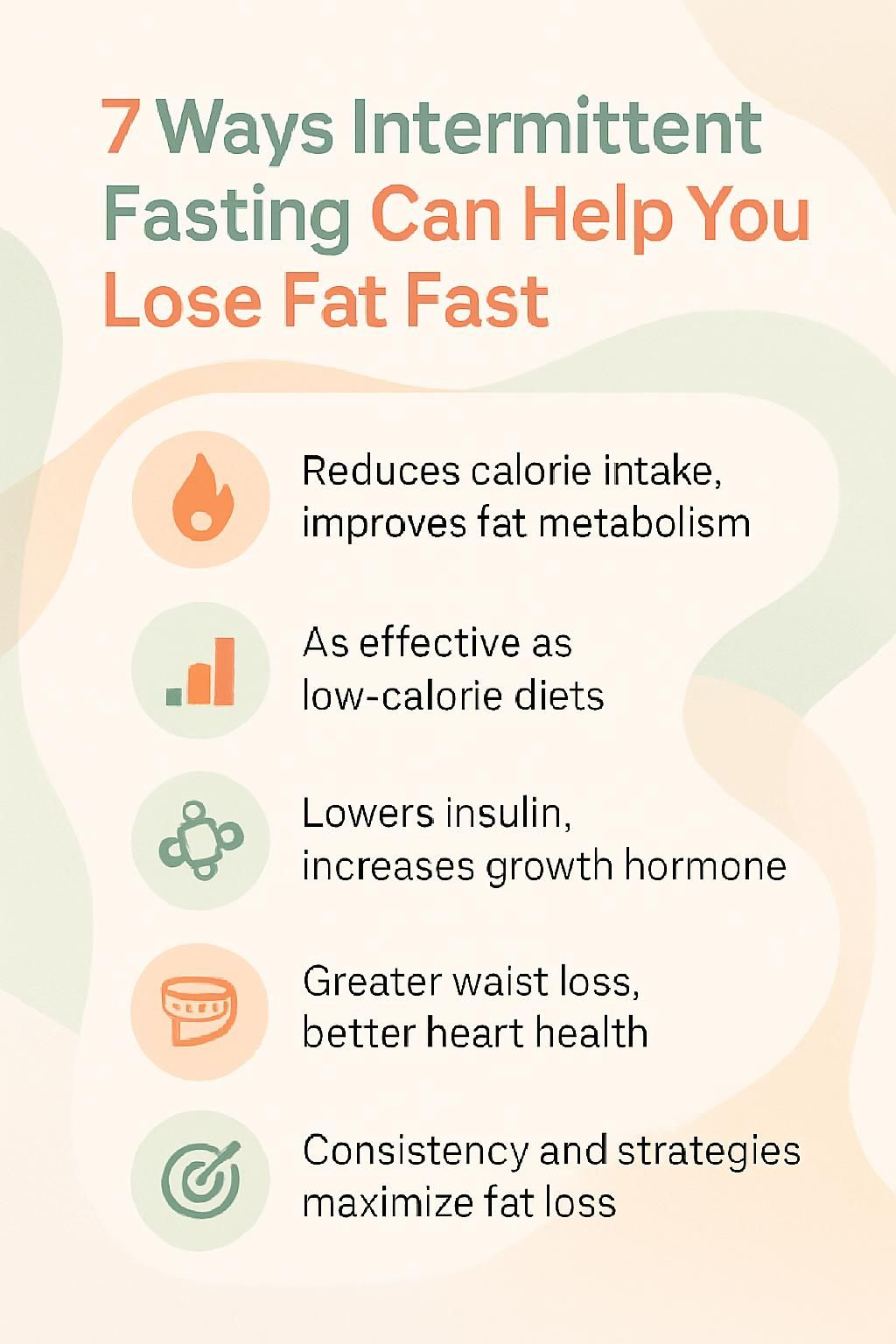7 Ways Intermittent Fasting Can Help You Lose Fat Fast
Our Nutrition Assistant AI Suite will transform your body. You will lose fat, get toned, and build muscle. Gain confidence and optimal health.
If you struggle to lose fat fast or feel stuck in your weight loss journey, intermittent fasting can help. This eating pattern creates a calorie deficit, supports fat loss, and fits busy schedules better than many strict diets. Intermittent fasting is an eating pattern that cycles between set times for eating and fasting. It can help you burn fat, improve key hormones, and support healthy weight management without cutting whole food groups.
You will see how different fasting methods burn more calories, balance hormones, reduce belly fat, and support health. You will also learn simple ways to use intermittent fasting for faster results and easier weight control.
Keep reading for seven practical tips that can change how you lose body fat.
Key Takeaways
- Intermittent fasting plans like 16:8, alternate day fasting, and the 5:2 diet cut calorie intake and improve fat metabolism without banning foods.
- A 2022 meta-analysis found intermittent fasting for up to 26 weeks is as effective for weight loss as daily low-calorie diets.
- Fasting lowers insulin and raises growth hormone, two changes that promote faster visceral and belly fat loss while helping preserve muscle.
- Clinical trials report greater drops in waist circumference with intermittent fasting than with many traditional diets, along with better heart health markers.
- Consistency with meal timing, hydration, protein intake, physical activity, and self-monitoring drives faster fat loss using intermittent fasting.

What Is Intermittent Fasting and Its Main Types?

Intermittent fasting is a simple structure that helps you lose weight and burn fat. You choose a schedule that matches your life and your goals, then keep your meals inside a set eating window.
What Are the Most Popular Intermittent Fasting Methods?
Several methods are popular because they are clear, flexible, and effective. Each offers unique benefits and fits different routines or weight targets.
- 16:8 Method
Fast for 16 hours each day, then eat all meals within an 8-hour window. Many start at noon and stop at 8 p.m. This pattern often trims calories and supports weight management. - Alternate Day Fasting
Eat normally one day, then keep fasting day intake very low, about 20 to 30 percent of needs. Studies show it can lower body mass index and support long-term fat loss. - 5:2 Diet
For two days each week, limit calories to about 500 to 600, and eat a regular diet on the other five days. The plan adds flexibility while controlling weekly calories. - 24-Hour Fast
Once or twice weekly, avoid food for a full 24 hours, such as dinner to dinner. Many use this to break a weight loss plateau and reduce abdominal fat. - Eat-Stop-Eat
Pick one or two nonconsecutive days per week to fast for 24 hours. Drink water, tea, or black coffee, and eat normally on other days to help manage calories. - Time-Restricted Eating (TRE)
Limit eating to a short daily window, often 6 to 10 hours, such as 9 a.m. to 5 p.m. This reduces late snacking and gives your body longer breaks from food.
Choose a plan that works with your schedule and health. A plan that fits your life is easier to keep.
How Does Intermittent Fasting Help You Lose Fat?
Intermittent fasting supports fat loss by cutting calories, improving metabolism, and promoting steady fat burning. Together, these changes create a strong base for healthy weight loss.
How Does Fasting Reduce Calorie Intake?
Shorter eating windows make it easier to eat fewer calories. With clear start and stop times, late-night snacking drops and portion sizes adjust naturally.
Tracking your meals in a journal or app helps you spot patterns and reduce mindless snacking. Research in 2020 and 2021 shows that people who track their food and weight lose more body weight and stick with plans longer.
Keeping a food diary increases awareness, which makes it easier to cut excess calories.
As your schedule settles, hunger cues reset and feel more predictable. Delaying your first meal lowers daily intake without banning favorite foods.
These shifts help many people lose belly fat and keep weight off with fewer rules and less stress.
How Does Intermittent Fasting Boost Fat Metabolism?
During a fast, your body first uses stored glucose, then shifts to body fat for energy. This switch increases fat metabolism. Insulin drops during fasting, and lower insulin signals your fat cells to release stored fuel.
Regular exercise adds to this effect. Aerobic exercise, such as brisk walking or cycling, and strength training both increase calorie burn and improve body composition. Simple tools like wearables can help you stay active and track progress.
Building lean muscle with strength work raises your daily calorie burn, even at rest. Pair your plan with a balanced diet that includes whole grains, fruits, vegetables, protein, and healthy fats like olive oil and nuts.
What Hormonal Benefits Does Fasting Provide?
Fasting improves key hormones. Insulin sensitivity increases, which means your cells use blood sugar more efficiently and store less fat. This shift lowers risk for type 2 diabetes and supports weight control.
Growth hormone, which helps you keep muscle and burn fat, rises during fasting. Appetite hormones shift too. Ghrelin, the hunger hormone, often drops after a few days, and leptin, the fullness signal, works more effectively over time.
In my own trial last year, pairing a 16:8 schedule with two weekly lifting sessions cut cravings for sugary snacks during my eating window.
Quality sleep also helps. Poor sleep raises cortisol and harms insulin sensitivity. Better sleep makes fasting easier and supports steady results.
Next, see how longer fasts nudge your body to burn fat at a faster rate.
Key Benefits of Intermittent Fasting for Fast Fat Loss
Intermittent fasting offers several benefits that support fat loss and better food choices. Many people see less abdominal obesity and an easier path to long-term weight control.
How Does Extended Fasting Encourage Fat Burning?
Extended fasting increases the hours your body spends without food, so it uses more stored fat for fuel. After about 12 hours, glucose runs low and your body breaks down triglycerides, which are stored fats, into fatty acids.
The liver turns some fatty acids into ketones, an alternative fuel for the brain and muscles. This process helps target both subcutaneous fat under the skin and visceral fat around organs.
Adding moderate to vigorous exercise during extended fasting can speed fat burning and improve fitness. For example, I paired a plant-focused diet with extended fasting and lifted weights three times a week, which helped me lose five kilograms in two months.
Research links this approach to better cholesterol and improved blood vessel function. Now, see how fasting also curbs calories in a natural way.
How Does Intermittent Fasting Naturally Reduce Calories?
Fasting limits the time you eat, which reduces the number of chances to overeat. With fewer meals and snacks, calorie intake falls without constant tracking.
Mindful eating gets easier too. You notice hunger and fullness cues more clearly inside your eating window. That makes it simpler to pass on convenience foods and sugary drinks that add calories fast.
Studies show that people using intermittent fasting often reduce daily calories without strict counting or low-fat rules.
How Does Insulin Regulation Improve Metabolism?
Lower calorie intake from fasting reduces insulin. Insulin is a hormone from the pancreas that helps move sugar from the blood into cells after you eat. High insulin encourages fat storage. Lower insulin helps your body use stored fat for energy and stabilize blood sugar.
Improved insulin sensitivity makes fat loss easier, especially around the waist. Many people also report better energy and fewer cravings once they settle into a steady eating window.
After moving to a 16-hour fast with an 8-hour eating window, I had steadier workouts and fewer urges for highly processed foods.
How Does Fasting Improve Hormonal Balance and Growth Hormone?
Fasting supports a healthier hormone balance that favors fat loss. Growth hormone can rise several times higher within 24 hours without food. Higher growth hormone helps protect muscle, reduces fat gain, and supports tissue repair while calories are low.
Fasting also helps reset ghrelin and leptin, which manage hunger and fullness. Together with lower insulin, this environment supports fat loss for people who carry extra weight or face obesity-linked conditions.
Keeping hormones steady through consistent fasting can promote ongoing fat reduction while preserving lean muscle for long-term strength.
Can Intermittent Fasting Target Belly Fat?
You cannot pick a single spot to lose fat. That said, intermittent fasting helps reduce total body fat, which includes fat around your waist. Better insulin sensitivity and fewer total calories push your body to draw from stored fat over time.
Belly fat, also called visceral fat, raises risk for heart disease and diabetes. A healthy waist is under 35 inches for most women and under 40 inches for most men.
Fasting often leads to bigger drops in waist size than many standard diets. I saw steady changes around week four once I paired a high-protein plan with a set eating window.
How Does Fasting Boost Workout Performance and Stamina?
Fasting can improve how your body uses fat during workouts, which helps stamina. As your body adapts, it relies less on fast carbs and more on stored fat for energy.
Training three to six days per week, with strength and moderate to vigorous sessions, can increase the amount of weight you lose. Better insulin control and higher growth hormone help protect muscle and support recovery.
Some people also choose lower carbohydrate eating with fasting. Studies suggest this pairing may improve strength and endurance better than dieting alone.
How Does Intermittent Fasting Support Sustainable Weight Management?
Better workout performance makes it easier to stay active. Consistent movement paired with clear meal timing builds habits you can keep for years.
Flexible eating windows help you think in routines rather than short-term restriction. People using these patterns are less likely to regain weight, especially if they favor nutrient-dense foods like avocado, bran, barley, and nuts.
This approach can help you lose fat effectively while building habits that protect long-term health.
What Does Research Say About Intermittent Fasting and Fat Loss?
Research suggests intermittent fasting is effective for weight loss and supports fat loss in many tissues. Here is what the science shows about this eating pattern.
What Are the Significant Studies on Fasting and Fat Loss?
Several major studies document the impact of intermittent fasting on weight loss and diet quality.
- A 2022 meta-analysis found intermittent fasting for up to 26 weeks is effective for weight loss and comparable to daily low-calorie diets. Many people use this plan to lose excess fat and maintain weight.
- A 2012 Johns Hopkins study reported that six months of weight loss from fasting improved artery function and blood flow, which supports heart and organ health.
- Studies show that shorter eating windows reduce calorie intake, so people often eat less without precise counting.
- Comparisons of different fasting types show alternate day fasting and time-restricted eating produce similar weight loss results, giving you options.
- Clinical trials report greater losses in visceral fat, including belly fat, with intermittent fasting compared to many standard diets.
- Evidence shows growth hormone rises during fasting, which supports fat use for energy while helping preserve lean muscle.
- Trials with overweight adults suggest intermittent fasting reduces weight regain risk, which supports long-term results.
These findings point to better hormone control, improved insulin response, and practical ways to reduce fat without strict bans on common foods.
How Does Intermittent Fasting Compare to Other Weight Loss Methods?
Intermittent fasting compares well to other approaches for both speed and quality of fat loss. This table summarizes evidence and practical takeaways.
| Method | Fat Loss Effectiveness | Muscle Retention | Ease of Compliance | Health Impact | Key Research Data | Personal Experience |
|---|---|---|---|---|---|---|
| Intermittent Fasting (IF) | Rapid fat loss from fewer meals and lower calories | Preserves lean muscle with adequate protein and strength work | Flexible timing, no food group bans, fits busy days | Improves insulin sensitivity, supports growth hormone, may lower inflammation | Studies report significant drops in body fat, including abdominal fat | You may notice better appetite control after week one and steadier energy |
| Low-Carb Diets | Average loss of 28.9 lbs in six months, compared to 18.7 lbs for low-fat | Greater fat loss and less muscle loss, roughly 2 to 3 lbs of lean mass | Restricts many foods, which can be hard in social settings | Improves metabolic health, lowers blood sugar and triglycerides | Supervised trials show higher quality weight loss and better markers | Hunger often drops at first, but social meals can be tricky |
| Low-Fat Diets | Average 18.7 lbs lost in six months, slower than low-carb | Higher risk of lean mass loss, slower fat loss | Many packaged foods fit, yet hunger and cravings can persist | Can lower cholesterol, weaker effect on insulin resistance | Research shows slower weight loss with more lean mass lost | Satiety can be a challenge, meals may feel less filling |
| Calorie Restriction (Traditional Dieting) | Gradual loss depends on tracking and consistency | Muscle loss is common without strength work and protein | Requires precise logging, which many find tedious | Can reduce chronic disease risk if balanced | Meta-analyses show modest steady loss, with frequent regain | Daily logging can feel exhausting, and progress may stall |
| Keto Diet | Rapid early loss from water and stored glycogen | Preserves muscle if protein is adequate | Strict carb limits make dining out hard | Lowers blood sugar, LDL cholesterol may rise for some | Short-term studies show quick loss, long-term adherence is tough | Fast early results are common, though keto flu can be difficult |
- Intermittent fasting blends flexibility, sustainable fat loss, and muscle protection better than many diets.
- Low-carb plans can produce larger losses, yet they demand more restriction.
- Managing meal timing through intermittent fasting often controls hunger better than strict calorie tracking.
How to Start Intermittent Fasting Successfully
You can start intermittent fasting with a simple plan, steady routines, and attention to your body’s signals. Clear steps make it easier to see progress.
How Do You Choose the Best Fasting Schedule?
Pick a schedule that reflects your daily rhythm and health needs. Test one plan for two to four weeks, then adjust based on energy, hunger, and sleep.
- Start with 16:8 if you are new. Fast for 16 hours and eat within an 8-hour window. This pattern fits most work or school days.
- Try Alternate Day Fasting for faster fat loss. Eat normally one day and restrict calories the next. Studies show strong fat loss results with this method.
- Use the 5:2 Diet for weekly flexibility. Eat normally five days, then keep two nonconsecutive days at 500 to 600 calories.
- Match your eating window to your workouts. If you train in the morning, open your window after exercise to support muscle building while losing fat.
- Check how your body responds during fasting, especially if you have lung issues, sleep loss, or other concerns. A registered dietitian can guide safe adjustments.
- Adapt your plan during stressful weeks. Shifting window times slightly can help you stay consistent without burnout.
- Talk with a healthcare professional if you take medications or have medical conditions that affect weight or blood sugar.
Perfection is not required. Most people refine their schedule as they go.
Why Is Staying Hydrated Important During Fasting?
Water supports every organ system, especially during a fast. Staying hydrated prevents headaches and fatigue and keeps metabolism working so you burn fat efficiently.
Plain water, unsweetened tea, and black coffee are safe during fasting hours. Infused water can make hydration more enjoyable without adding calories.
Keeping a bottle nearby helped me avoid headaches and stay focused during my last fasting cycle. Even mild dehydration can slow fat loss by reducing how well your body uses stored fat for energy.
How Can You Manage Eating Windows Effectively?
Planning your meals inside a set window prevents rushed choices and overeating. Structure helps you hit your calorie and protein targets with less stress.
- Plan balanced, nutrient-dense meals. Include vegetables, fruits, whole grains, lean protein, and healthy fats.
- Include protein at every meal, such as eggs, yogurt, fish, beans, or poultry. Protein supports muscle while your body burns stored fat.
- Pick a consistent window, like 16:8 or 18:6. Keep it steady so your body and schedule stay aligned.
- Space meals evenly. For example, one meal at the start of your window and another later or a small snack between.
- Eat slowly and mindfully so fullness signals reach your brain. This helps prevent overeating.
- Drink water with and between meals. Hydration supports digestion and helps control appetite.
- Track intake with a simple app or journal to align calories with your weight loss plan.
These steps make your window easier to follow and support effective fat loss.
How to Overcome Common Intermittent Fasting Challenges
Fasting gets easier with practice. Use the strategies below to handle hunger, fight energy dips, and stay consistent through busy weeks.
How Can You Handle Hunger While Fasting?
Hunger often peaks during the first two weeks. Use these tips to curb cravings and stay on track.
- Drink water often to reduce hunger pangs and support organ function.
- Choose high-fiber foods, such as whole grains, beans, vegetables, fruits, nuts, and seeds, during eating windows.
- Eat mindfully. Slow down and notice fullness cues to prevent overeating.
- Build meals with protein, healthy fat, and complex carbs for steady energy.
- Use zero-calorie drinks like herbal tea or black coffee to blunt appetite.
- Take short walks. Light movement distracts from hunger and lifts mood.
- Keep your schedule steady. Most people notice less hunger after two weeks.
- Prioritize sleep to reduce cravings and improve hormone balance.
- Plan meals in advance. A plan reduces impulsive snacking.
Adding a serving of nuts during my eating window kept me satisfied longer and made it easier to stick with my plan.
What Are Effective Ways to Combat Energy Lows?
Energy dips can happen early on. Small changes prevent those lows and support steady fat loss.
- Hydrate all day to prevent fatigue related to dehydration.
- Focus on nutrient-rich foods like leafy greens, lean proteins, whole grains, and nuts during your eating window.
- Add healthy fats such as avocados and nut butters for sustained energy.
- Schedule short walks if you feel sluggish. Activity trackers can help you move more.
- Include strength training three days a week to build stamina and use fat for fuel.
- Break your fast with balanced meals that include protein, healthy carbs, and fat.
- Protect your sleep. Poor rest lowers energy and harms weight control.
- Use stress management, such as deep breathing, to support stable hormones.
These habits support metabolism, help regulate hormones, and make fasting more sustainable.
How Do You Maintain Consistency with Fasting?
Consistency brings results. A few simple habits keep your plan steady and your progress visible.
- Track weight, meals, and workouts with a journal or an app. This builds accountability.
- Set eating windows that fit your life and keep them steady each day.
- Connect with health-minded friends or groups for support in social situations.
- Keep healthy snacks ready for your window to avoid high-calorie choices.
- Celebrate small wins, such as a full week on plan or a new low on the scale.
- Meal prep for your window using nutrient-dense foods to avoid last-minute choices.
- Keep a water bottle nearby during fasting hours to avoid mistaking thirst for hunger.
A clear plan helps you stay ready for common hurdles like hunger and low energy.
Who Should Avoid or Be Cautious with Intermittent Fasting?
Fasting is not right for everyone. If you have medical concerns, talk with your clinician before you start a new plan.
What Health Conditions Make Fasting Unsafe?
Some health conditions make fasting risky. Check this list to see if you should avoid or delay fasting.
- Type 1 diabetes, or any diabetes with frequent lows, raises the risk of dangerous hypoglycemia. Speak with your doctor first.
- Eating disorders, including anorexia and bulimia, can worsen with fasting routines.
- Pregnant or breastfeeding people need steady nutrition for growth and milk production.
- Chronic illnesses like heart, kidney, or liver disease often require timed meals and medication.
- Medications that must be taken with food may conflict with long fasts.
- Children and teens need regular meals for proper growth and development.
- Underweight individuals risk malnutrition with meal skipping and calorie cuts.
I once tried fasting while low in iron and felt exhausted, so I stopped and sought care. Always check your health status before changing your eating pattern.
Which Groups Need Professional Guidance Before Fasting?
Some groups should consult a clinician or registered dietitian before starting intermittent fasting.
- People with chronic conditions such as diabetes, heart disease, or kidney issues.
- Pregnant or breastfeeding individuals, due to higher nutrient needs.
- Anyone with a history of disordered eating.
- Teens and children, since growth requires steady fuel and nutrients.
- Older adults who may have unique nutrition needs or medication schedules.
- People using prescription medications that require food for best absorption.
- Those who are underweight or losing weight without trying.
Professional guidance helps you balance safety, medication timing, and your weight goals.
How to Enhance Intermittent Fasting with Healthy Habits
Simple lifestyle habits boost fasting results. Focus on food quality, movement, sleep, and stress to make progress faster and keep it longer.
What Nutrient-Rich Foods Should You Include?
Nutrient-dense foods help you feel full, protect muscle, and keep energy steady. Aim for protein, fiber, and healthy fats at each meal.
- Pick protein sources such as eggs, tofu, tempeh, edamame, nut butters, Greek yogurt, cottage cheese, salmon, sardines, beans, lentils, and lean poultry.
- Choose whole grains instead of white bread or white rice. Consider whole grain cereal, bread, pasta, or brown rice for steady energy.
- Fill plates with fruits like berries and apples and vegetables like carrots and spinach for vitamins and fiber.
- Add peas, beans, pulses, nuts, and seeds to push fiber above 25 grams per day.
- Snack on chia pudding or a small handful of nuts instead of sweets to avoid blood sugar spikes.
- Swap fruit juice for water or a milk-based smoothie with fruits or leafy greens.
- Use legumes such as lentils or black beans in soups and salads for extra protein and fiber.
Next, learn how exercise and strength work can speed your progress.
How Does Exercise and Strength Training Help?
Exercise raises calorie burn during and after each session. Strength training builds lean muscle, which increases your resting metabolism, so you burn more calories all day.
The Centers for Disease Control and Prevention suggests at least 150 minutes of moderate activity each week plus muscle-strengthening work on two days. This combination helps reduce abdominal fat and reshape your body.
If you want lasting weight loss, pair protein-rich meals with steady strength training. Your metabolism works harder, and fat loss becomes more efficient.
How Do Sleep and Stress Affect Fasting Results?
Poor sleep can slow your results. A 2022 review found that sleep loss harms how your body turns food into energy. That pushes the body to store more fat and raises hunger.
When sleep drops, ghrelin rises and leptin falls. You feel hungrier and crave more food the next day. Stress adds another barrier. High cortisol, the stress hormone, promotes abdominal fat and makes weight loss harder.
Research from 2018 shows that stress management, such as deep breathing or guided imagery, can lower BMI more over eight weeks when paired with healthy eating patterns, including intermittent fasting.
Summary: Better sleep and lower stress support hormone balance, curb hunger, and speed progress with intermittent fasting.
Frequently Asked Questions About Intermittent Fasting
These answers cover common concerns about intermittent fasting and weight loss. Use them to fine-tune your plan.
Can Intermittent Fasting Specifically Target Belly Fat?
You cannot target one body part for fat loss. As total body fat drops, inches around the waist usually fall too. Health experts suggest a waist under 35 inches for most women and under 40 inches for most men to lower risk for heart disease and diabetes.
My waistline changed after several weeks of consistent windows and patient calorie control. Genetics decide where you lose fat first, so give your plan time to work.
How Long Does It Take to See Fat Loss Results?
Visible changes can appear in two to four weeks with consistent intermittent fasting. A 2022 meta-analysis reported effective weight loss within 26 weeks.
Progress varies with your starting point, metabolism, and plan adherence. Johns Hopkins research in 2012 also found improved artery function after six months of steady weight loss.
Is Intermittent Fasting Safe for Most People?
Intermittent fasting is safe for most healthy adults and can lower body fat while improving certain health markers. Some groups should avoid or use caution, such as people with diabetes, pregnant or breastfeeding individuals, those under 18, and anyone with a history of disordered eating.
Speak with your clinician before starting any fasting plan if you have medical conditions or take medications.
Conclusion
Intermittent fasting can help you lose fat fast through simple, proven methods. Plans like 16:8 or 5:2 create a calorie deficit, improve insulin and growth hormone, and support healthy metabolism without extreme rules.
Research shows intermittent fasting can work as well as traditional diets for fat loss, including belly fat. Track your meals and activity, pick nutrient-dense foods, lift weights or add aerobic exercise, and adjust based on how you feel.
If you have medical concerns or take prescription drugs, consult a healthcare professional before you try intermittent fasting. With a safe plan and steady habits, you can reach your weight loss goals and maintain a healthy weight.
FAQs
1. How does intermittent fasting support weight loss and fat reduction?
Intermittent fasting helps the body use stored fat for energy during periods without food intake. This process can lead to a decrease in overall body weight and promote steady weight loss.
2. What evidence supports the link between intermittent fasting and effective weight loss?
Several clinical studies show that people who follow intermittent fasting routines often experience greater reductions in body mass compared to those on standard calorie-restricted diets. These findings suggest that structured eating windows may enhance fat burning.
3. Can intermittent fasting improve metabolic health while aiding weight loss?
Research indicates that intermittent fasting can lower insulin levels, reduce inflammation, and boost metabolism; these changes help facilitate more efficient fat breakdown, supporting long-term weight management goals.
4. Is it safe to use intermittent fasting as a primary method for rapid fat loss?
Most healthy adults tolerate short-term intermittent fasting well when following recommended guidelines. However, consulting with a healthcare provider before starting any new diet plan is important for safety and sustained results in both weight loss and overall health.
Summary: Intermittent fasting offers several benefits related to losing excess body mass quickly by promoting natural fat usage, improving metabolic markers, and providing an alternative approach to traditional dieting methods focused on calorie restriction alone.







